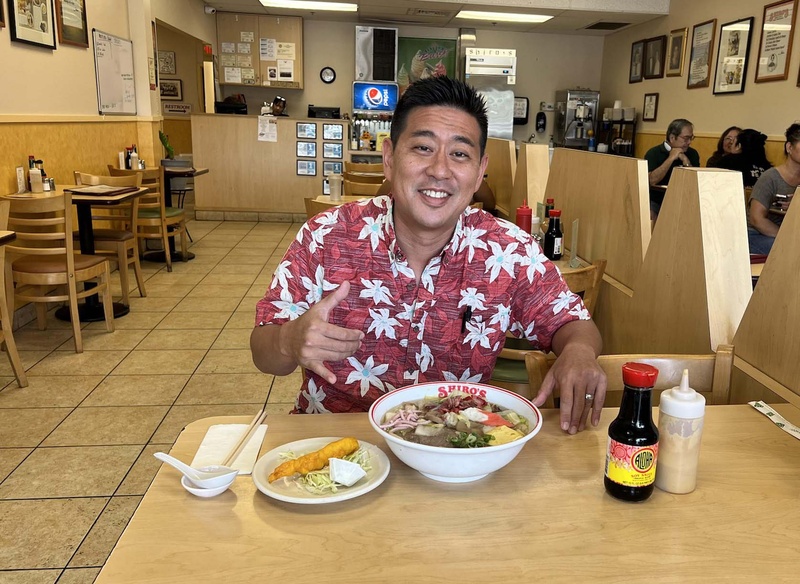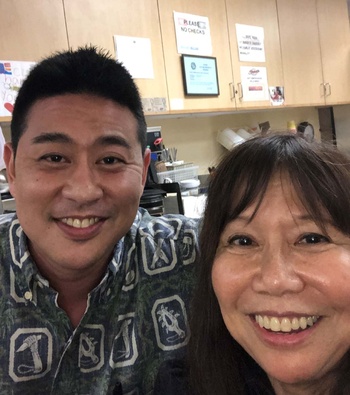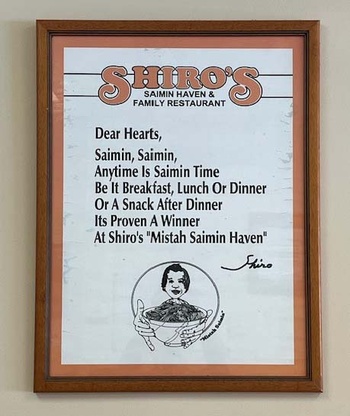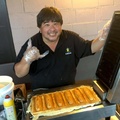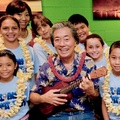In 1969, Bryce Fujimoto’s grandfaddah, da late Franz “Shiro” Matsuo opened up da first Shiro’s Saimin Haven in ‘Aiea on ‘Oahu wea he had da unconventional idea for have one restaurant centered around Hawai‘i’s favorite-est noodle soup dish, saimin!
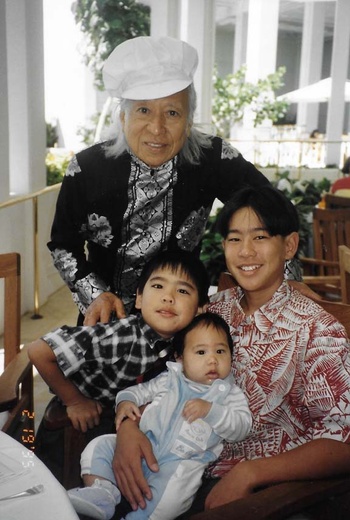
During Braddah Bryce’s hanabattah [childhood] days, thoughts of saimin and legacy wuz da furthest tings from his mind. For him, small kid time wuz all about going beach and riding bike around his Mānoa neighborhood. When asked if he wuz Shiro’s favorite grandchild, he laughed and said, “No. I was not.”
See, cuz Braddah Bryce stay 43 now, but when he wuz one kid he wuzn’t really into following rules and going to school and stuffs li’dat. Luckily he eventually got it into gear and graduated from da Shidler College of Business at The University of Hawai‘i at Mānoa. During his time there he was even the Vice President of the Society for Human Resource Management.
Today he proudly works as da numbah two boss under his mom, Linda Matsuo, and as da third generation successor to da business, he knows he would be making his grandfaddah proud.
* * * * *
Lee Tonouchi (LT): What school you went, what year you grad?
Bryce Fujimoto (BF): Well, I went to multiple high schools, but I graduated from Mid-Pac [Mid-Pacific Institute], class of 2000.
LT: How you identify as? Local? Local Japanese? Japanese American? Nikkei?
BF: Local Japanese.
LT: For da people who dunno, you can try explain what is saimin?
BF: Saimin is a uniquely Local dish that was created in Hawai‘i. I think saimin started off in the plantation days because it was a simple, easier meal to make. Back in those days, they made the soup base with dried shrimp a lot and then they would add their noodles and whatnot in there.
LT: Some people confuse saimin with ramen. You can try explain da difference.
BF: One major difference between ramen and saimin is the broth, actually. So the noodles are very similar, but the broth for ramen is a lot richer, a lot thicker. A lot of times it’s cooked for hours and hours with pork bones and pork stock and whatnot. And it’s a very rich, in-a-bowl kind of meal.
But the dashi [broth] for the saimin is light and more crisp. So it’s made from bonito, which is fish flakes, kombu or kelp. And also we have a little bit of clam base in ours too. So that would be the major difference, the broth. That’s why for saimin, we like to pair our saimin with fried items because it just works well together.
LT: You can try tell how your grandfaddah’s approach to saimin wuz radicals.
BF: The difference between our saimin and the saimin of the past is that Shiro, he kind of glamorized saimin. So he put all these other things inside of it and partnered it with other side items and really made a meal out of something that was seen as a snack prior.
LT: Shiro’s stay known for having dozens and dozens of different varieties of saimin. You can try tell da top 3?
BF: Okay, so definitely our signature saimin is The Dodonpa, number 58. And that one has a lot of stuff inside. It has Chinese roast pork, roast beef, imitation crab, mushrooms. Then we have our handmade wun tun in there. We have won bok and the garnishes, which are char siu, luncheon meat, and green onions. And then you get a side of what we call fried shrimp, but it’s actually like our version of shrimp tempura.
I think number two would be the number 55, the Ron Mizutani Saimin. That one comes with a wun tun min, which has the noodles, wun tun, vegetables and garnish. And then it has a side of our hula burger. And we named this after [the former television newscaster] Ron Mizutani because he was always a patron.
The third most popular I would say is the number 44, the Char Siu Saimin, which is basically like our wun tun min with all the garnishes, but we load up on the shaved char siu on there. And it really changes the flavor of the broth.
LT: Try name all da job titles you had at Shiro’s.
BF: So I worked in every single position in the restaurant. I was Waterboy first. And then I was Busser, then Saimin Cook, Fry Cook, Host, Counter Worker and Server.
I first became a Manager in the early 2000s. I currently am the VP Catering Manager and I would say about six years ago I also became the General Manager of our Waimalu location.
LT: Who you grateful to in your journey in rising up da saimin ranks?
BF: It’s going to be my mom, Linda Matsuo. She’s helped me grow and realize many things. I’ll be the first to admit that I was not the ideal son. I didn't always listen and I tested boundaries a lot. And my mom really helped me through a lot of difficult situations.
LT: Like what?
BF: Okay. So... you remember how I said I went to multiple high schools? I got asked to leave ‘Iolani multiple times. And that was probably the lowest part of my life. And my mom, she helped pick me up. At that time I was an angry kid who didn’t follow the rules. I left ‘Iolani, and I went to Roosevelt, then I went to Mid-Pac.
I should have appreciated the opportunity I had with a great school like Mid-Pac. However I did not, and I cut out of school a lot. So much so that my grades dropped and I was about to fail my Philosophy class and not graduate.
But my mom went down there and talked to the principal and tried to convince them to give me another chance. And it worked! So that’s how I was able to graduate from Mid-Pac and I’m just eternally grateful for that. When really she could have just given up on me.
LT: So what your mom told dem that wuz so convincing?
BF: My mom asked the principal if he would allow her to talk to my Philosophy teacher. In the meeting with the teacher she said, “My son is an a-hole right now. But you know that Bryce is a capable kid. Please give him a chance to do extra work in order to boost his grade to a passing level. I know he is a lot to deal with, but do you really want to have him AGAIN in your class next year?”
LT: Hahahaha. Too funny your mom. Is it one blessing or one burden for help carry on da family legacy.
BF: Well, I definitely think it’s a blessing. It comes with challenges, of course. But I definitely think it’s a blessing. My mom, Linda, and my grandpa, Shiro, they basically did all the hard work. So all I have to do is just not mess up and keep it going.
LT: Shiro’s has been around since 1969 and currently get two locations. One in Ewa Beach and da Waimalu location. What’s da secret to your restaurant’s longevity?
BF: You know, Shiro, he came up with a very good business model. He came up with a lot of great items on the menu and it’s geared as like homestyle cooking. It’s comfort food. So it’s not anything flashy. So he set things up and we’ve continued to keep things simple. Also, he always used to tell me, keep it simple, stupid, you know, because you don’t want to make things so complicated that nobody else can duplicate it. You want to make something that’s easy, repeatable and good. Consistency is the most difficult thing that you can accomplish. But that’s our goal. Besides that, we have a very, very strong and loyal core of employees and management here. They are just awesome.
LT: So what wuz your relationship like with your grandfaddah?
BF: (Laughing) I was probably his least favorite grandchild growing up. But it wasn’t only because of how I was doing in school. It was just that I was so much younger. In his mind, I was kind of, I don’t want to say worthless, but, I was a just of a different generation. Compared to all the things that he accomplished in his life, I can understand his perspective.
LT: Mr. Shiro had one big and infectious personality. Da story goes that I had one birthday when I wuz baby and my family ordered da catering from Shiro’s. Mr. Shiro wen delivery da food himself and “coincidentally” he wen so happen for have his ‘ukulele with him in da car so he sang happy birthday to me. Is there pressure for you for fill his shoes as one entertainer?
BF: (Laughing) As far as ‘ukulele and entertainment and, you know, performing, that’s really not my jam. So the very most I’ll do is I’ll be as welcoming and as cordial as possible to the customers that come in.
But I have been continuing on with the writing of his Dear Hearts poems because before he passed in 2012 he did ask me to continue that. I was a little nervous about it, but he said, “Bryce, just write... from your heart.”
LT: Wow! So it’s like you went from least favorite to da chosen one! Being asked for take ova da Dear Hearts, das like da highest honor. For da people who nevah been inside Shiro’s, you can try explain da significance of his Dear Hearts poems.
BF: Shiro had a tradition where he would write a poem every single week. He published a book of his Dear Hearts poems and it’s like gold because it’s kind of like a peek into his mind at every stage of his life.
Many of Shiro’s heartfelt poems adorn our walls at the restaurant. They are meant to give encouragement to eaters who he considered to be friends. The poems that I write for social media, I sign them as Bryce “Saimin Jr.”
LT: Try give us one sample.
BF: Here’s an example from something I wrote in 2015.
Too Busy!!
Dear Hearts,
Sometimes it feels like you have a million things to do in a day.
So much is on your plate, you just want to pack your bags and run away.
When this happens try to take a deep breath and analyze.
What needs to be done first? Prioritize!
Delegate what you can and take things in stride.
Do your best the first time, and do it with PRIDE!Sincerely,
Bryce “Saimin Jr.”
LT: Do you feel like you have to leave your own personal mark on da business?
BF: I’m not really thinking of leaving a signature mark, but I do see a lot of aspects of the business that can be built up. For example, I helped boost the catering department to include school, construction and large company accounts.
I also want to do more with our merchandising. Shiro wrote a book, he made CDs, he made all of these Shiro’s-branded items. We always have to order shirts and we can’t keep it stocked because everyone keeps on buying it. I definitely want to continue making merchandise and find new ways to promote the brand.
LT: So what “Saimin Jr.,” how old your mom now and when you tink she going pass da saimin torch ova to you?
BF: (Laughing) I don’t think Linda wants to disclose how old she is. She’s definitely retirement age, past retirement age. I know she’s not going to retire soon, but she has cut back on her hours. Instead of coming in to work six days a week, she only comes in five days now!
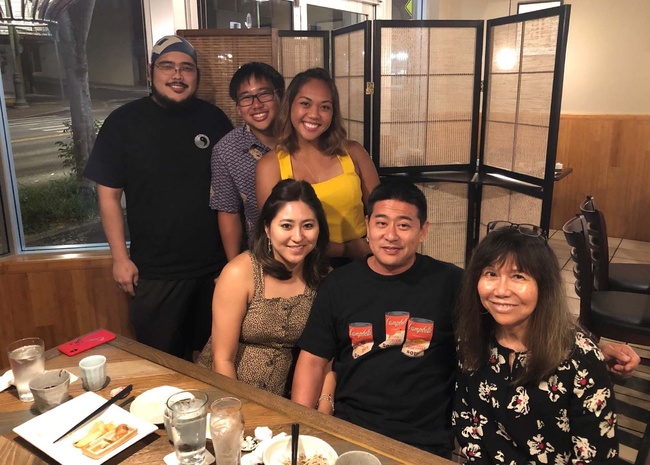
© 2024 Lee A. Tonouchi


